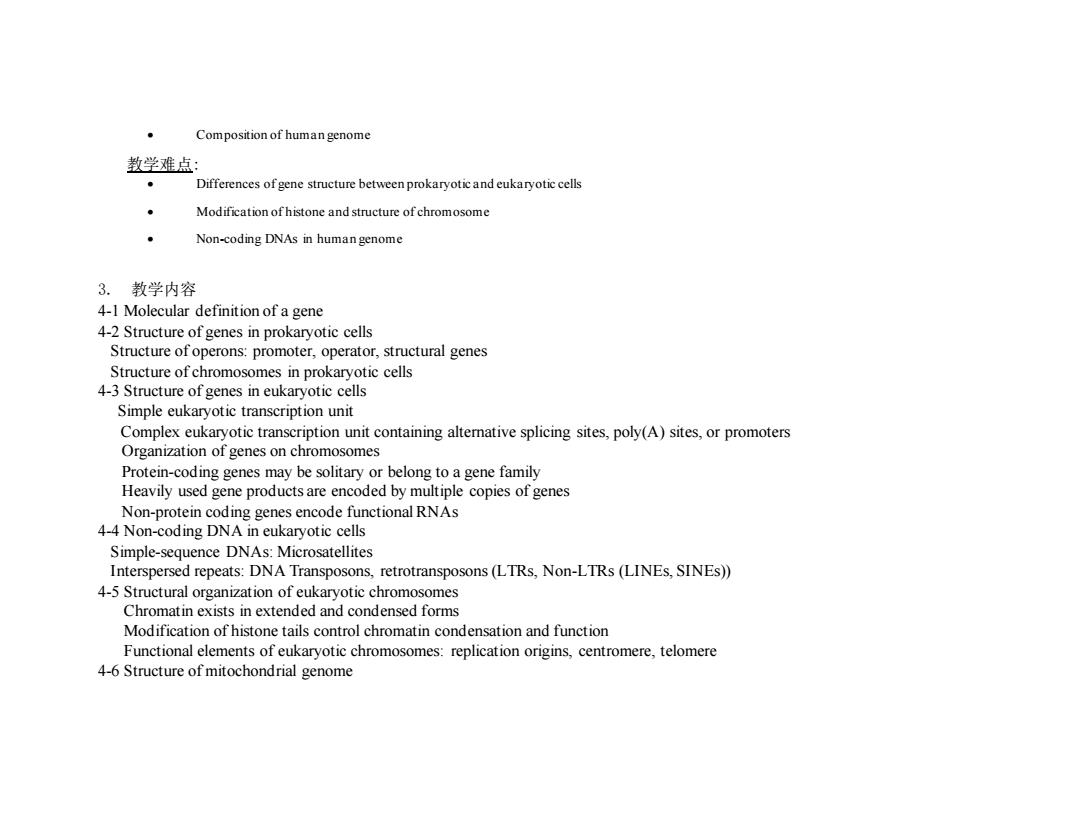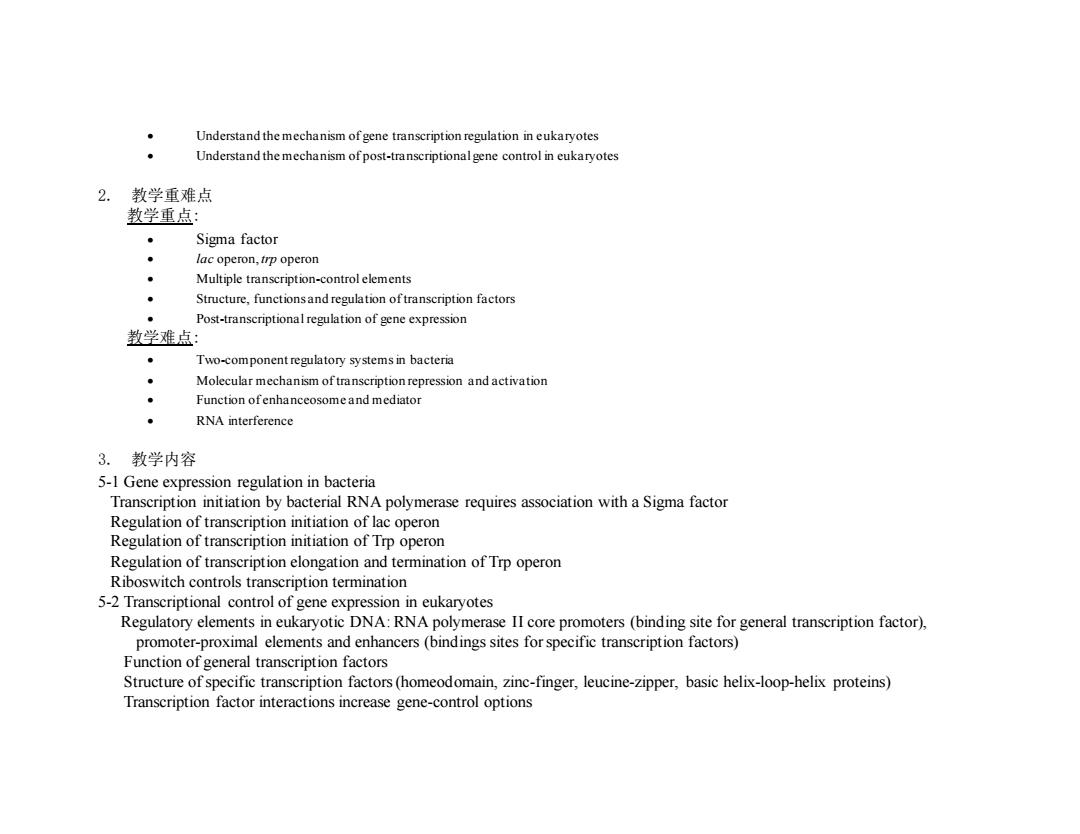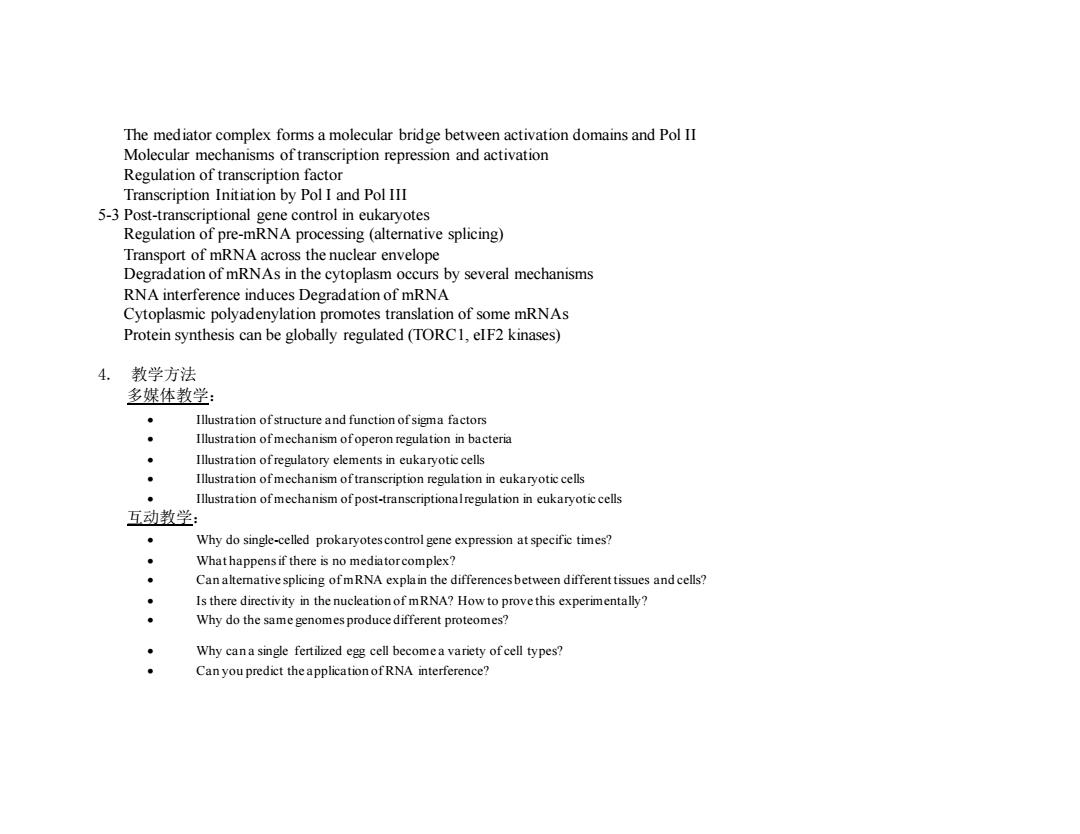
Why is mRNA more stable when it is added a 5'cap or a 3'poly-A tail? There are 61 codons,but how can many cells have less than 61 tRNAs? What is the proofreading mechanism of protein translation? 5.教学评价 课后问题: What are the differences of central dogma between prokaryotes and eukaryotes? Can you write the mRNA sequence (or non-template DNA sequence)when given the template DNA strand sequence? What is the proofreading mechanism in RNA synthesis? How is eukaryotic pre-mRNA processed? What differences can you identify between DNA synthesis and RNA synthesis? What are the proofreading mechanism in protein synthesis? What are the functions of A,P,E sites in ribosomes during translation? What are the functions of GTP-bid ing proteins in translation? Chapter4.Genes,,genomics and chromosomes(滕昕辰) 1.教学目标 ● Understand the structure of genes and all the functionalelements within a gene Be able to identify single genes,gene families,and pseudogenes Be able to understand the influence of various non-coding DNA on genome formation Understand how DNA is folded step by stepto form the higher structure of chromosomes Understand the effect of histone tail modification on chromosome structure and transcription 2.教学重难点 教学重点: Structure of genes and all the functionalelements within a gene Structure of chromosomes Differences of gene structure and chromosome structure between prokaryotic and eukaryotic cells
• Why is mRNA more stable when it is added a 5 'cap or a 3' poly-A tail? • There are 61 codons, but how can many cells have less than 61 tRNAs? • What is the proofreading mechanism of protein translation? 5. 教学评价 课后问题: • What are the differences of central dogma between prokaryotes and eukaryotes? • Can you write the mRNA sequence (or non-template DNA sequence) when given the template DNA strand sequence? • What is the proofreading mechanism in RNA synthesis? • How is eukaryotic pre-mRNA processed? • What differences can you identify between DNA synthesis and RNA synthesis? • What are the proofreading mechanism in protein synthesis? • What are the functions of A, P, E sites in ribosomes during translation? • What are the functions of GTP-biding proteins in translation? Chapter 4. Genes, genomics and chromosomes(滕昕辰) 1. 教学目标 • Understand the structure of genes and all the functional elements within a gene • Be able to identify single genes, gene families, and pseudogenes • Be able to understand the influence of various non-coding DNA on genome formation • Understand how DNA is folded step by step to form the higher structure of chromosomes • Understand the effect of histone tail modification on chromosome structure and transcription 2. 教学重难点 教学重点: • Structure of genes and all the functional elements within a gene • Structure of chromosomes • Differences of gene structure and chromosome structure between prokaryotic and eukaryotic cells

Composition of human genome 教学难点: Differences of gene structure between prokaryotic and eukaryotic cells Modification ofhistone and structure of chromosome Non-coding DNAs in human genome 3.教学内容 4-1 Molecular definition of a gene 4-2 Structure of genes in prokaryotic cells Structure of operons:promoter,operator,structural genes Structure of chromosomes in prokaryotic cells 4-3 Structure of genes in eukaryotic cells Simple eukaryotic transcription unit Complex eukaryotic transcription unit containing alternative splicing sites,poly(A)sites,or promoters Organization of genes on chromosomes Protein-coding genes may be solitary or belong to a gene family Heavily used gene products are encoded by multiple copies of genes Non-protein coding genes encode functional RNAs 4-4 Non-coding DNA in eukaryotic cells Simple-sequence DNAs:Microsatellites Interspersed repeats:DNA Transposons,retrotransposons(LTRs,Non-LTRs (LINEs,SINEs)) 4-5 Structural organization of eukaryotic chromosomes Chromatin exists in extended and condensed forms Modification of histone tails control chromatin condensation and function Functional elements of eukaryotic chromosomes:replication origins,centromere,telomere 4-6 Structure of mitochondrial genome
• Composition of human genome 教学难点: • Differences of gene structure between prokaryotic and eukaryotic cells • Modification of histone and structure of chromosome • Non-coding DNAs in human genome 3. 教学内容 4-1 Molecular definition of a gene 4-2 Structure of genes in prokaryotic cells Structure of operons: promoter, operator, structural genes Structure of chromosomes in prokaryotic cells 4-3 Structure of genes in eukaryotic cells Simple eukaryotic transcription unit Complex eukaryotic transcription unit containing alternative splicing sites, poly(A) sites, or promoters Organization of genes on chromosomes Protein-coding genes may be solitary or belong to a gene family Heavily used gene products are encoded by multiple copies of genes Non-protein coding genes encode functional RNAs 4-4 Non-coding DNA in eukaryotic cells Simple-sequence DNAs: Microsatellites Interspersed repeats: DNA Transposons, retrotransposons (LTRs, Non-LTRs (LINEs, SINEs)) 4-5 Structural organization of eukaryotic chromosomes Chromatin exists in extended and condensed forms Modification of histone tails control chromatin condensation and function Functional elements of eukaryotic chromosomes: replication origins, centromere, telomere 4-6 Structure of mitochondrial genome

4. 教学方法 多媒体教学: Illustrations of differences between the prokaryotic and eukaryotic cells Illustrations of structure of genes and chromosomes in prokaryotic and eukaryotic cells Illustration ofmechanism oftransposons Illustration ofstructure of chromosome 互动教学: A prokaryotic operon can be transcribed into how many transcription units,how many proteins? What is the physiological significance of complex transcription units in eukaryotes? What kind of genes need multiple copies? Can transposons cause severe mutations? Between the loose and compact chromosome,which one is easier to be transcribed? 5. 教学评价 课后问题: What are the differences of gene structure between eukaryotes and prokaryotes? Can you give a big picture of the human genome compositions? Describe the differences between solitary genes,gene families,pseudogenes,and tandemly repeated genes How is the repetitious DNA useful for identifying individuals by the technique of DNA fingerprinting? What is a nucleosome?What role do histones play in nucleosomes? How do chromatin modifications regulate transcription?What modifications are observed in regions of the genome that are actively transcribed and not actively transcribed? How would a chromosome be affected if it lacked (a)replication origins or(b)a centromere? Can proteins be synthesized inside mitochondria?Are all the mitochondrial proteins synthesized within mitochondria? Chapter5.Control of gene expression(滕昕辰) 1.教学目标(五号宋体) Understand the mechanism of gene transcription regulation in prokaryotes
4. 教学方法 多媒体教学: • Illustrations of differences between the prokaryotic and eukaryotic cells • Illustrations of structure of genes and chromosomes in prokaryotic and eukaryotic cells • Illustration of mechanism of transposons • Illustration of structure of chromosome 互动教学: • A prokaryotic operon can be transcribed into how many transcription units, how many proteins? • What is the physiological significance of complex transcription units in eukaryotes? • What kind of genes need multiple copies? • Can transposons cause severe mutations? • Between the loose and compact chromosome, which one is easier to be transcribed? 5. 教学评价 课后问题: • What are the differences of gene structure between eukaryotes and prokaryotes? • Can you give a big picture of the human genome compositions? • Describe the differences between solitary genes, gene families, pseudogenes, and tandemly repeated genes. • How is the repetitious DNA useful for identifying individuals by the technique of DNA fingerprinting? • What is a nucleosome? What role do histones play in nucleosomes? • How do chromatin modifications regulate transcription? What modifications are observed in regions of the genome that are actively transcribed and not actively transcribed? • How would a chromosome be affected if it lacked (a) replication origins or (b) a centromere? • Can proteins be synthesized inside mitochondria? Are all the mitochondrial proteins synthesized within mitochondria? Chapter 5. Control of gene expression(滕昕辰) 1. 教学目标 (五号宋体) • Understand the mechanism of gene transcription regulation in prokaryotes

Understand the mechanism of gene transcription regulation in eukaryotes Understand the mechanism ofpost-transcriptional gene control in eukaryotes 2. 教学重难点 教学重点: Sigma factor lac operon,trp operon Multiple transcription-control elements Structure,functionsand regulation oftranscription factors Post-transcriptional regulation of gene expression 教学难点: Two-component regulatory systems in bacteria Molecular mechanism oftranscription repression and activation Function ofenhanceosome and mediator ● RNA interference 3.教学内容 5-1 Gene expression regulation in bacteria Transcription initiation by bacterial RNA polymerase requires association with a Sigma factor Regulation of transcription initiation of lac operon Regulation of transcription initiation of Trp operon Regulation of transcription elongation and termination of Trp operon Riboswitch controls transcription termination 5-2 Transcriptional control of gene expression in eukaryotes Regulatory elements in eukaryotic DNA:RNA polymerase II core promoters (binding site for general transcription factor), promoter-proximal elements and enhancers (bindings sites for specific transcription factors) Function of general transcription factors Structure of specific transcription factors(homeodomain,zinc-finger,leucine-zipper,basic helix-loop-helix proteins) Transcription factor interactions increase gene-control options
• Understand the mechanism of gene transcription regulation in eukaryotes • Understand the mechanism of post-transcriptional gene control in eukaryotes 2. 教学重难点 教学重点: • Sigma factor • lac operon, trp operon • Multiple transcription-control elements • Structure, functions and regulation of transcription factors • Post-transcriptional regulation of gene expression 教学难点: • Two-component regulatory systems in bacteria • Molecular mechanism of transcription repression and activation • Function of enhanceosome and mediator • RNA interference 3. 教学内容 5-1 Gene expression regulation in bacteria Transcription initiation by bacterial RNA polymerase requires association with a Sigma factor Regulation of transcription initiation of lac operon Regulation of transcription initiation of Trp operon Regulation of transcription elongation and termination of Trp operon Riboswitch controls transcription termination 5-2 Transcriptional control of gene expression in eukaryotes Regulatory elements in eukaryotic DNA: RNA polymerase II core promoters (binding site for general transcription factor), promoter-proximal elements and enhancers (bindings sites for specific transcription factors) Function of general transcription factors Structure of specific transcription factors (homeodomain, zinc-finger, leucine-zipper, basic helix-loop-helix proteins) Transcription factor interactions increase gene-control options

The mediator complex forms a molecular bridge between activation domains and Pol II Molecular mechanisms of transcription repression and activation Regulation of transcription factor Transcription Initiation by Pol I and Pol III 5-3 Post-transcriptional gene control in eukaryotes Regulation of pre-mRNA processing (alternative splicing) Transport of mRNA across the nuclear envelope Degradation of mRNAs in the cytoplasm occurs by several mechanisms RNA interference induces Degradation of mRNA Cytoplasmic polyadenylation promotes translation of some mRNAs Protein synthesis can be globally regulated (TORC1,elF2 kinases) 4. 教学方法 多媒体教学: Illustration ofstructure and function of sigma factors Illustration ofmechanism ofoperon regulation in bacteria Illustration ofregulatory elements in eukaryotic cells Illustration of mechanism oftranscription regulation in eukaryotic cells Illustration ofmechanism of post-transcriptionalregulation in eukaryotic cells 互动教学: Why do single-celled prokaryotes control gene expression at specific times? What happens if there is no mediatorcomplex? Can altemative splicing ofmRNA explain the differences between different tissues and cells? Is there directivity in the nucleation of mRNA?How to prove this experimentally? Why do the same genomes produce different proteomes? Why can a single fertilized egg cell become a variety of cell types? Can you predict the application ofRNA interference?
The mediator complex forms a molecular bridge between activation domains and Pol II Molecular mechanisms of transcription repression and activation Regulation of transcription factor Transcription Initiation by Pol I and Pol III 5-3 Post-transcriptional gene control in eukaryotes Regulation of pre-mRNA processing (alternative splicing) Transport of mRNA across the nuclear envelope Degradation of mRNAs in the cytoplasm occurs by several mechanisms RNA interference induces Degradation of mRNA Cytoplasmic polyadenylation promotes translation of some mRNAs Protein synthesis can be globally regulated (TORC1, eIF2 kinases) 4. 教学方法 多媒体教学: • Illustration of structure and function of sigma factors • Illustration of mechanism of operon regulation in bacteria • Illustration of regulatory elements in eukaryotic cells • Illustration of mechanism of transcription regulation in eukaryotic cells • Illustration of mechanism of post-transcriptional regulation in eukaryotic cells 互动教学: • Why do single-celled prokaryotes control gene expression at specific times? • What happens if there is no mediator complex? • Can alternative splicing of mRNA explain the differences between different tissues and cells? • Is there directivity in the nucleation of mRNA? How to prove this experimentally? • Why do the same genomes produce different proteomes? • Why can a single fertilized egg cell become a variety of cell types? • Can you predict the application of RNA interference?